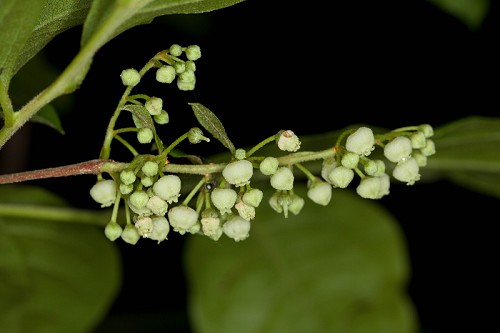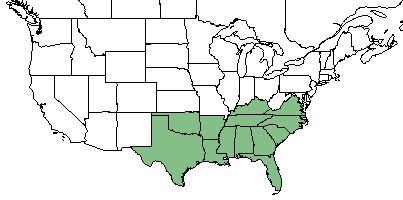Difference between revisions of "Lyonia ligustrina"
Lsandstrum (talk | contribs) |
Emmazeitler (talk | contribs) |
||
| Line 1: | Line 1: | ||
{{italic title}} | {{italic title}} | ||
| − | Common name: | + | Common name: Maleberry<ref name= "USDA Plant Database"/>, He-huckleberry<ref name= "Weakley 2015"/> |
<!-- Get the taxonomy information from the NRCS Plants database --> | <!-- Get the taxonomy information from the NRCS Plants database --> | ||
{{taxobox | {{taxobox | ||
| Line 19: | Line 19: | ||
}} | }} | ||
==Taxonomic Notes== | ==Taxonomic Notes== | ||
| − | Synonyms: ''Arsenococcus frondosus'' (Pursh) Small; ''Xolisma foliosiflora'' (Michaux) Small | + | Synonyms: ''Arsenococcus frondosus'' (Pursh) Small; ''Xolisma foliosiflora'' (Michaux) Small; ''Xolisma ligustrina'' (Linnaeus) Britton.<ref name="weakley">Weakley, A.S. 2015. Flora of the southern and mid-atlantic states. Working Draft of 21 May 2015. University of North Carolina at Chapel Hill, Chapel Hill, North Carolina.</ref> |
| − | Varieties: ''Lyonia ligustrina'' (Linnaeus) A.P. de Candolle var. ''foliosiflora'' (Michaux) Fernald | + | Varieties: ''Lyonia ligustrina'' (Linnaeus) A.P. de Candolle var. ''foliosiflora'' (Michaux) Fernald; ''Lyonia ligustrina'' (Linnaeus) A.P. de Candolle ''var. ligustrina''.<ref name="weakley">Weakley, A.S. 2015. Flora of the southern and mid-atlantic states. Working Draft of 21 May 2015. University of North Carolina at Chapel Hill, Chapel Hill, North Carolina.</ref> |
==Description== | ==Description== | ||
<!-- Basic life history facts such as annual/perrenial, monoecious/dioecious, root morphology, seed type, etc. --> | <!-- Basic life history facts such as annual/perrenial, monoecious/dioecious, root morphology, seed type, etc. --> | ||
| − | ''L. ligustrina'' is a perennial shrub of the ''Ericaceae'' family native to North America. <ref name= "USDA Plant Database"> USDA Plant Database [https://plants.usda.gov/core/profile?symbol=LYLIF https://plants.usda.gov/core/profile?symbol=LYLIF] </ref> | + | ''L. ligustrina'' is a perennial shrub of the ''Ericaceae'' family native to North America.<ref name= "USDA Plant Database"> USDA Plant Database [https://plants.usda.gov/core/profile?symbol=LYLIF https://plants.usda.gov/core/profile?symbol=LYLIF] </ref> |
==Distribution== | ==Distribution== | ||
| − | ''L. ligustrina'' is | + | ''L. ligustrina var. foliosiflora'' ranges from southeast Virginia to central Florida, west to eastern Texas and eastern Oklahoma, and north to Tennessee and Arizona. Var. ''foliosiflora'' is the usual variety on the Coastal Plain. ''Lyonia ligustrina var. ligustrina'' ranges from southern Maine, southern New Hampshire, southern Vermont, southeastern New York, southern Ohio, West Virginia, and Kentucky, south to west-central South Carolina, northern Georgia, and northeastern Alabama. Var. ''ligustrina'' is the usual variety in the Mountains and Piedmont, but also extends into the Coastal Plains of North Carolina and South Carolina.<ref name="weakley">Weakley, A.S. 2015. Flora of the southern and mid-atlantic states. Working Draft of 21 May 2015. University of North Carolina at Chapel Hill, Chapel Hill, North Carolina.</ref> |
==Ecology== | ==Ecology== | ||
===Habitat=== <!--Natural communities, human disturbed habitats, topography, hydrology, soils, light, fire regime requirements for removal of competition, etc.--> | ===Habitat=== <!--Natural communities, human disturbed habitats, topography, hydrology, soils, light, fire regime requirements for removal of competition, etc.--> | ||
| − | ''L. ligustrina'' is found in pocosins, seepage bogs, mountain bogs, shrub balds, bottomlands, other moist to wet habitats, and "dry" exposed ridges at high elevations. <ref name= "Weakley 2015">Weakley, A. S. (2015). Flora of the Southern and Mid-Atlantic States. Chapel Hill, NC, University of North Carolina Herbarium. </ref> Specimens have been collected from wet woodland along streams, swampy woodland, pine flatwoods, cypress swamp, and low wet savanna. <ref name = "FSU herbarium"> URL: http://herbarium.bio.fsu.edu. Last accessed: June 2018. Collectors: R.K. Godfrey, Angus Gholson, Wilson Baker, Cecil Slaughter, S.W. Leonard, Robert | + | ''L. ligustrina'' is found in pocosins, seepage bogs, mountain bogs, shrub balds, bottomlands, other moist to wet habitats, and "dry" exposed ridges at high elevations.<ref name= "Weakley 2015">Weakley, A. S. (2015). Flora of the Southern and Mid-Atlantic States. Chapel Hill, NC, University of North Carolina Herbarium. </ref> Specimens have been collected from wet woodland along streams, swampy woodland, pine flatwoods, cypress swamp, and low wet savanna.<ref name = "FSU herbarium"> URL: http://herbarium.bio.fsu.edu. Last accessed: June 2018. Collectors: R.K. Godfrey, Angus Gholson, Wilson Baker, Cecil Slaughter, S.W. Leonard, Robert Simmons, Jim Bickner, R.D. Houk, Elmer Prichard, Mary Margaret Williams, Sidney McDaniel, R.A. Norris, R. Komarek, William Platt. States and counties: Florida (Liberty, Hamilton, Volusia, Wakulla, Jefferson, Orange, Lake, Marion, Walton, Polk, Taylor, Leon, Duval, Osceola, Santa Rosa, Washington) Georgia (Thomas)</ref> ''L. ligustrina'' responds positively to soil disturbance by heavy silviculture in North Carolina.<ref>Cohen, S., R. Braham, and F. Sanchez. (2004). Seed Bank Viability in Disturbed Longleaf Pine Sites. Restoration Ecology 12(4):503-515.</ref> |
===Phenology=== <!--Timing off flowering, fruiting, seed dispersal, and environmental triggers. Cite PanFlora website if appropriate: http://www.gilnelson.com/PanFlora/ --> | ===Phenology=== <!--Timing off flowering, fruiting, seed dispersal, and environmental triggers. Cite PanFlora website if appropriate: http://www.gilnelson.com/PanFlora/ --> | ||
| − | ''L. ligustrina'' | + | ''L. ligustrina var. foliosiflora'' flowers from late April through June, and fruits from September through October. ''L. ligustrina var. ligustrina'' flowers from May through July and fruits from September through October.<ref name="weakley">Weakley, A.S. 2015. Flora of the southern and mid-atlantic states. Working Draft of 21 May 2015. University of North Carolina at Chapel Hill, Chapel Hill, North Carolina.</ref> |
<!--===Seed dispersal===--> | <!--===Seed dispersal===--> | ||
<!--===Seed bank and germination===--> | <!--===Seed bank and germination===--> | ||
| Line 44: | Line 44: | ||
==Conservation and Management== | ==Conservation and Management== | ||
| − | ''L. ligustrina'' is listed as possibly extirpated by the Ohio Department of Natural Resources Division of Natural Areas and Preserves. <ref name= "USDA Plant Database"/> | + | ''L. ligustrina'' is listed as possibly extirpated by the Ohio Department of Natural Resources Division of Natural Areas and Preserves.<ref name= "USDA Plant Database"/> |
==Cultivation and restoration== | ==Cultivation and restoration== | ||
Revision as of 12:55, 28 September 2020
Common name: Maleberry[1], He-huckleberry[2]
| Lyonia ligustrina | |
|---|---|

| |
| Photo by the Southeastern Flora Database | |
| Scientific classification | |
| Kingdom: | Plantae |
| Division: | Magnoliophyta - Flowering plants |
| Class: | Magnoliopsida - Dicots |
| Order: | Ericales |
| Family: | Ericaceae |
| Genus: | Lyonia |
| Species: | L. ligustrina |
| Binomial name | |
| Lyonia ligustrina L. | |

| |
| Natural range of Lyonia ligustrina from USDA NRCS Plants Database. | |
Contents
Taxonomic Notes
Synonyms: Arsenococcus frondosus (Pursh) Small; Xolisma foliosiflora (Michaux) Small; Xolisma ligustrina (Linnaeus) Britton.[3]
Varieties: Lyonia ligustrina (Linnaeus) A.P. de Candolle var. foliosiflora (Michaux) Fernald; Lyonia ligustrina (Linnaeus) A.P. de Candolle var. ligustrina.[3]
Description
L. ligustrina is a perennial shrub of the Ericaceae family native to North America.[1]
Distribution
L. ligustrina var. foliosiflora ranges from southeast Virginia to central Florida, west to eastern Texas and eastern Oklahoma, and north to Tennessee and Arizona. Var. foliosiflora is the usual variety on the Coastal Plain. Lyonia ligustrina var. ligustrina ranges from southern Maine, southern New Hampshire, southern Vermont, southeastern New York, southern Ohio, West Virginia, and Kentucky, south to west-central South Carolina, northern Georgia, and northeastern Alabama. Var. ligustrina is the usual variety in the Mountains and Piedmont, but also extends into the Coastal Plains of North Carolina and South Carolina.[3]
Ecology
Habitat
L. ligustrina is found in pocosins, seepage bogs, mountain bogs, shrub balds, bottomlands, other moist to wet habitats, and "dry" exposed ridges at high elevations.[2] Specimens have been collected from wet woodland along streams, swampy woodland, pine flatwoods, cypress swamp, and low wet savanna.[4] L. ligustrina responds positively to soil disturbance by heavy silviculture in North Carolina.[5]
Phenology
L. ligustrina var. foliosiflora flowers from late April through June, and fruits from September through October. L. ligustrina var. ligustrina flowers from May through July and fruits from September through October.[3]
Conservation and Management
L. ligustrina is listed as possibly extirpated by the Ohio Department of Natural Resources Division of Natural Areas and Preserves.[1]
Cultivation and restoration
Photo Gallery
References and notes
- ↑ 1.0 1.1 1.2 USDA Plant Database https://plants.usda.gov/core/profile?symbol=LYLIF
- ↑ 2.0 2.1 Weakley, A. S. (2015). Flora of the Southern and Mid-Atlantic States. Chapel Hill, NC, University of North Carolina Herbarium.
- ↑ 3.0 3.1 3.2 3.3 Weakley, A.S. 2015. Flora of the southern and mid-atlantic states. Working Draft of 21 May 2015. University of North Carolina at Chapel Hill, Chapel Hill, North Carolina.
- ↑ URL: http://herbarium.bio.fsu.edu. Last accessed: June 2018. Collectors: R.K. Godfrey, Angus Gholson, Wilson Baker, Cecil Slaughter, S.W. Leonard, Robert Simmons, Jim Bickner, R.D. Houk, Elmer Prichard, Mary Margaret Williams, Sidney McDaniel, R.A. Norris, R. Komarek, William Platt. States and counties: Florida (Liberty, Hamilton, Volusia, Wakulla, Jefferson, Orange, Lake, Marion, Walton, Polk, Taylor, Leon, Duval, Osceola, Santa Rosa, Washington) Georgia (Thomas)
- ↑ Cohen, S., R. Braham, and F. Sanchez. (2004). Seed Bank Viability in Disturbed Longleaf Pine Sites. Restoration Ecology 12(4):503-515.